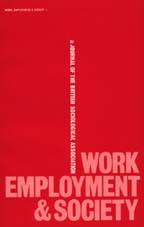Crossref Citations
This article has been cited by the following publications. This list is generated based on data provided by
Crossref.
Jacobs, Kerry
2003.
CLASS REPRODUCTION IN PROFESSIONAL RECRUITMENT: EXAMINING THE ACCOUNTING PROFESSION.
Critical Perspectives on Accounting,
Vol. 14,
Issue. 5,
p.
569.
Young, Jun
and
Foot, Kirsten
2005.
Corporate E-Cruiting: The Construction of Work in Fortune 500 Recruiting Web Sites.
Journal of Computer-Mediated Communication,
Vol. 11,
Issue. 1,
p.
44.
Zimdars, Anna
Sullivan, Alice
and
Heath, Anthony
2009.
Elite Higher Education Admissions in the Arts and Sciences: Is Cultural Capital the Key?.
Sociology,
Vol. 43,
Issue. 4,
p.
648.
Diewald, Martin
and
Mayer, Karl Ulrich
2009.
The sociology of the life course and life span psychology: Integrated paradigm or complementing pathways?.
Advances in Life Course Research,
Vol. 14,
Issue. 1-2,
p.
5.
Dörfler, Laura
and
van de Werfhorst, Herman G.
2009.
EMPLOYERS' DEMAND FOR QUALIFICATIONS AND SKILLS.
European Societies,
Vol. 11,
Issue. 5,
p.
697.
Zimdars, Anna
2010.
The profile of pupil barristers at the Bar of England and Wales 2004–2008.
International Journal of the Legal Profession,
Vol. 17,
Issue. 2,
p.
117.
Souto‐Otero, Manuel
2010.
Education, meritocracy and redistribution.
Journal of Education Policy,
Vol. 25,
Issue. 3,
p.
397.
Kriesi, Irene
Buchmann, Marlis
and
Sacchi, Stefan
2010.
Variation in job opportunities for men and women in the Swiss labor market 1962–1989.
Research in Social Stratification and Mobility,
Vol. 28,
Issue. 3,
p.
309.
Wiborg, Øyvind Nicolay
and
Møberg, Rasmus Juul
2010.
Social origin and the risks of disadvantage in Denmark and Norway: the early life course of young adults.
Work, Employment and Society,
Vol. 24,
Issue. 1,
p.
105.
Fevre, Ralph
2012.
Social Mobility, Equity and the Politics of Recruitment.
Sociology Compass,
Vol. 6,
Issue. 9,
p.
740.
Kurekova, Lucia
Beblavy, Miroslav
Haita, Corina
and
Thum, AnnaaElisabeth
2013.
Demand for Low- and Medium-Skilled Workers Across Europe: Between Formal Qualifications and Non-Cognitive Skills.
SSRN Electronic Journal,
Devine, Fiona
and
Li, Yaojun
2013.
The changing relationship between origins, education and destinations in the 1990s and 2000s.
British Journal of Sociology of Education,
Vol. 34,
Issue. 5-6,
p.
766.
Bye, Hege Høivik
Horverak, Jøri Gytre
Sandal, Gro Mjeldheim
Sam, David Lackland
and
van de Vijver, Fons JR
2014.
Cultural fit and ethnic background in the job interview.
International Journal of Cross Cultural Management,
Vol. 14,
Issue. 1,
p.
7.
Weiss, Felix
Klein, Markus
and
Grauenhorst, Thomas
2014.
The effects of work experience during higher education on labour market entry: learning by doing or an entry ticket?.
Work, Employment and Society,
Vol. 28,
Issue. 5,
p.
788.
Saar, Ellu
Unt, Marge
Helemäe, Jelena
Oras, Kaja
and
Täht, Kadri
2014.
What is the role of education in the recruitment process? Employers’ practices and experiences of graduates from tertiary educational institutions in Estonia.
Journal of Education and Work,
Vol. 27,
Issue. 5,
p.
475.
Passaretta, Giampiero
and
Triventi, Moris
2015.
Work experience during higher education and post-graduation occupational outcomes: A comparative study on four European countries.
International Journal of Comparative Sociology,
Vol. 56,
Issue. 3-4,
p.
232.
Kureková, Lucia Mýtna
Beblavý, Miroslav
and
Thum-Thysen, Anna
2015.
Using online vacancies and web surveys to analyse the labour market: a methodological inquiry.
IZA Journal of Labor Economics,
Vol. 4,
Issue. 1,
Mýtna Kureková, Lucia
Beblavý, Miroslav
Haita, Corina
and
Thum, Anna-Elisabeth
2016.
Employers’ skill preferences across Europe: between cognitive and non-cognitive skills.
Journal of Education and Work,
Vol. 29,
Issue. 6,
p.
662.
Spinath, Frank M.
and
Bleidorn, Wiebke
2017.
The New Look of Behavioral Genetics in Social Inequality: Gene‐Environment Interplay and Life Chances.
Journal of Personality,
Vol. 85,
Issue. 1,
p.
5.
Tijdens, Kea
Beblavý, Miroslav
and
Thum-Thysen, Anna
2018.
Skill mismatch comparing educational requirements vs attainments by occupation.
International Journal of Manpower,
Vol. 39,
Issue. 8,
p.
996.


